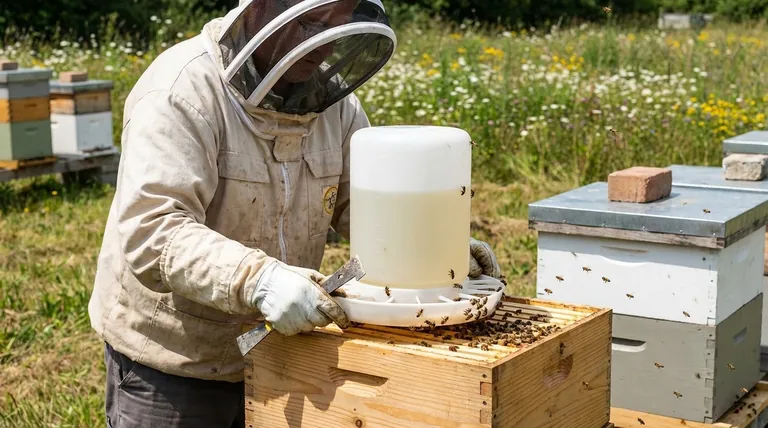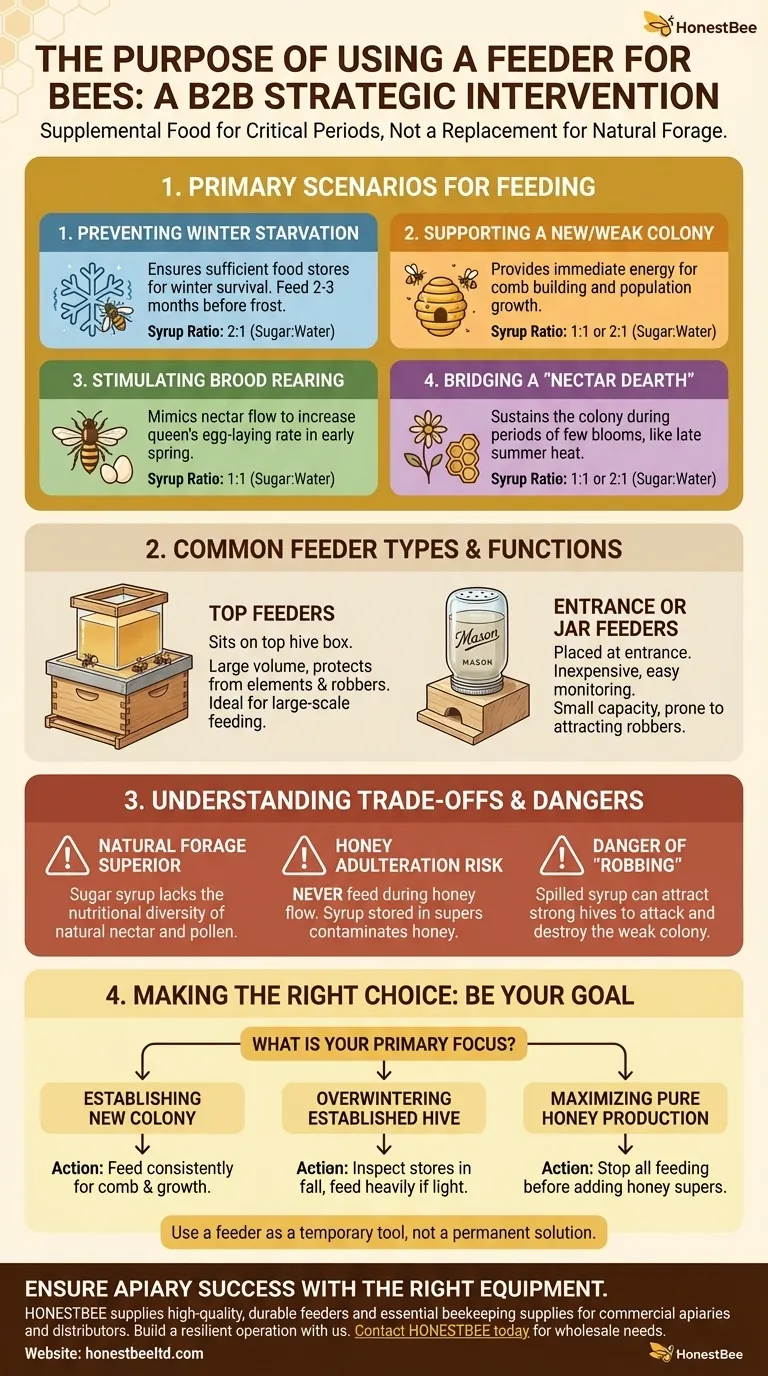The fundamental purpose of a bee feeder is to provide a honey bee colony with supplemental food, such as sugar syrup or pollen substitutes, during critical periods. It is a strategic intervention used by beekeepers to ensure a hive's survival and health when natural nectar and pollen sources are insufficient.
A feeder is not a replacement for natural foraging; it is a focused tool used as a last resort. The goal is to provide a temporary helping hand, allowing the bees to thrive on their own once conditions improve, as natural resources are always superior for their needs.

The Primary Scenarios for Feeding a Hive
A beekeeper's decision to feed a colony is based on specific, time-sensitive needs. Feeding outside of these windows can do more harm than good.
Preventing Winter Starvation
The most critical use of a feeder is to ensure a colony has enough food stores to survive the winter.
Beekeepers feed a 2:1 sugar-to-water syrup two to three months before the first frost. This gives the bees ample time to process the syrup, store it as "honey," and raise the final generations of "winter bees" needed to keep the colony warm.
Supporting a New or Weak Colony
A newly installed package of bees or a small nucleus colony has an immense amount of work to do. They must build comb, raise brood, and gather resources simultaneously.
Feeding provides the immediate energy required for this initial build-up, significantly increasing their chances of becoming a strong, self-sufficient colony before the season ends.
Stimulating Brood Rearing
In early spring, a beekeeper might lightly feed a hive a 1:1 sugar-to-water syrup.
This mimics a natural nectar flow, signaling to the queen that resources are abundant. In response, she will increase her egg-laying rate, boosting the colony's population in preparation for the main honey flow.
Bridging a "Nectar Dearth"
A nectar dearth is a period when few or no plants are blooming, often occurring in the intense heat of late summer.
During a dearth, a colony can quickly consume its stores. Feeding helps the bees survive this gap until autumn flowers begin to bloom.
Common Feeder Types and Their Functions
Different feeders serve different purposes and are suited for various situations.
Top Feeders
A top feeder is a shallow box that sits directly on top of the uppermost hive box, beneath the main cover.
It holds a large volume of syrup and includes a mechanism, like hardware cloth, that allows bees to access the food without drowning. This design protects the syrup from rain, wind, and robber bees from other hives.
Entrance or Jar Feeders
These feeders, often constructed from a simple Mason jar with small holes in the lid, are placed at the hive entrance.
They are excellent for new or small colonies because they are inexpensive and make it easy to monitor how quickly the bees are consuming the feed. However, their small capacity and exposed location can make them prone to attracting robbers.
Understanding the Trade-offs and Dangers
While essential at times, feeding comes with significant responsibilities and potential downsides.
Why Natural Forage is Always Superior
Natural nectar and pollen provide a complex blend of sugars, proteins, vitamins, and minerals that humans cannot perfectly replicate. Sugar syrup is a carbohydrate substitute that keeps bees alive, but it lacks the nutritional diversity of natural sources.
The Risk of Honey Adulteration
Feeding should never occur when a beekeeper intends to harvest honey. If bees are fed syrup while honey-collecting boxes ("supers") are on the hive, they will store that syrup in the honeycomb.
This adulterates the final product, creating "syrup honey" instead of pure, natural honey. Responsible beekeepers remove all feeders long before the main nectar flow begins.
The Danger of "Robbing"
Spilled syrup or poorly designed feeders can attract bees from stronger, nearby hives.
This can trigger a "robbing" frenzy, where the invading bees attack the weaker colony to steal its resources. A severe robbing event can decimate or completely destroy the hive being fed.
Making the Right Choice for Your Colony
The decision to feed is a direct reflection of your goals as a beekeeper.
- If your primary focus is establishing a new colony: You will almost certainly need to feed consistently to help them build comb and establish a strong population.
- If your primary focus is overwintering an established hive: Inspect their food stores in the fall and feed heavily if they are light, stopping before the weather turns too cold.
- If your primary focus is maximizing pure honey production: Stop all feeding well before you add your honey supers to ensure the integrity of your harvest.
Ultimately, using a feeder is a sign of a responsive beekeeper—one who observes their hives and provides support only when it is truly needed.
Summary Table:
| Scenario | Purpose of Feeding | Recommended Feed/Syrup Ratio |
|---|---|---|
| Preventing Winter Starvation | Build sufficient food stores for survival | 2:1 (Sugar:Water) |
| Supporting a New/Weak Colony | Provide energy for comb building and population growth | 1:1 or 2:1 (Sugar:Water) |
| Stimulating Brood Rearing | Mimic a nectar flow to increase queen's egg-laying rate | 1:1 (Sugar:Water) |
| Bridging a Nectar Dearth | Sustain the colony during periods of low natural forage | 1:1 or 2:1 (Sugar:Water) |
Ensure your apiary's success with the right equipment.
As a beekeeper, you know that timely intervention with the right tools is key to a thriving colony. HONESTBEE supplies commercial apiaries and beekeeping equipment distributors with high-quality, durable feeders and essential beekeeping supplies through our wholesale-focused operations. Let us help you build a more resilient and productive operation.
Contact HONESTBEE today to discuss your wholesale needs and equip your hives for success.
Visual Guide

Related Products
- Mini Desktop Bee Hive Frame Forming Making Machine
- HONESTBEE Bee Frame Side Bar Forming Machine Precision Engineered for High-Volume Production Bee Frame Machine
- Slatted Porter Style Bee Escape for Rapid Hive Clearing
- Automatic Pneumatic Bee Frame Machine for Eyelet Insertion
- Automatic Honey Filling and Filtering Machine for Beekeeping Bottle Filling
People Also Ask
- What are the advantages of using the Beehive Frame Making Machine? Boost Apiary Efficiency & Self-Sufficiency
- How are Langstroth beehive frames assembled? A Step-by-Step Guide for a Durable Hive
- What is the difference between assembled and unassembled beehive frames? Save Time or Money for Your Hive
- What is the role of oxalic acid in plants? A Key to Plant Defense and Internal Regulation
- Why are Langstroth and Dadant beehive frames popular choices for honey extractors? Maximize Your Honey Yield with Standardized Equipment



















